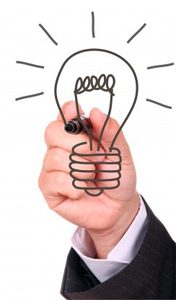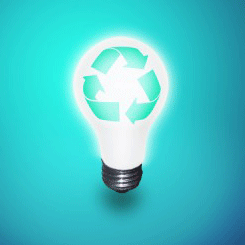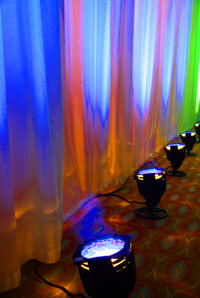Best Lighting Solutions for Trade Shows
Proper lighting is an essential component of your tradeshow booth and can help increase traffic and create a favorable environment in which to pitch your company’s products. According to booth design expert, Bruce Baker, who’s published articles on booth lighting, a good lighting system that functions at peak performance will boost sales more than any other item you can purchase.
Your lighting requirements will vary depending on your specific promotional goals, display configuration, exhibit color and design, booth lighting fixtures, and space. To determine what type of lighting will best create effective, creative exhibit illumination, you must carefully consider the following questions:
- What area or product in your booth will need to be the focal point?
- What visual impact, impression, or message do you want to convey through lighting?
 When you want to create a spotlight effect to highlight one particular area of interest in your exhibit, you might consider overhead truss lighting. If you’d rather create a more inviting, warm and welcoming atmosphere to make prospects feel more comfortable, you might select a soft lamp or ambient lighting.
When you want to create a spotlight effect to highlight one particular area of interest in your exhibit, you might consider overhead truss lighting. If you’d rather create a more inviting, warm and welcoming atmosphere to make prospects feel more comfortable, you might select a soft lamp or ambient lighting.
Special illumination techniques can be used to create a more dramatic atmosphere that can possibly draw more attendees to your booth by setting it apart from competing booths. Determining the mood you want to create—exciting and dynamic or warm and inviting—will go a long way towards helping you determine the most appropriate lighting.
Other questions to ask when weighing your lighting options are:
- What type of lighting is being supplied by the exhibition facility?
- How much power will be available in your booth?
- Would additional power be available, if your lighting needs require it?
- How are light fixtures attached to your display?
- How much can you spend on display lighting systems?
Once these questions are answered, you can go to your lighting supplier and find the best solutions for your particular needs. Good lighting can lead to increased booth traffic, additional sales leads, and possibly higher resulting sales, so choose wisely.
How to Make Exhibits Eco-Friendly
According to the Environmental Protection Agency (EPA), trade shows are the #2 producer of waste in the U.S., following the construction industry, a dubious honor indeed. So what can you do as an exhibitor to be more environmentally responsible? Though it would be difficult, if not impossible, to have a tradeshow exhibit that’s is 100% sustainable, the goal of many companies is to move more in the “green” direction. Doing so might not be as difficult as it once was as many exhibit companies are now offering more and more sustainable exhibits.
 What makes it eco-friendly? Good question. Let’s take a look at some of the options for companies wanting to create eco-friendly exhibits.
What makes it eco-friendly? Good question. Let’s take a look at some of the options for companies wanting to create eco-friendly exhibits.
One way to reduce waste is to choose exhibits made from materials that are eco-friendly, meaning they are made of renewable, recycled and sustainable materials. The frames of exhibit systems can be made out of aluminum, which is 100% recyclable. Substrates, panels, banner stands can be constructed out of other recyclable materials, such as Sorghum, bamboo, PET plastic, cardboard, and biodegradable foam board.
Another huge energy waster is lighting. Choose LED lighting instead, which reduces energy usage by 90%. Exhibitors can even go green on the printing on displays by using low Volatile Organic Compound (VOC) inks and eco materials.
Lest we forget shipping, many exhibit companies are offering shipping cases that are made entirely of recycled plastic so the entire case can be recycled. These are also often very lightweight, again reducing the amount of energy, or carbon footprint, associating with shipping it.
Tradeshow Display Lighting – Is LED the Way to go?
Trade Show Display Lighting Can Make Your Booth Stand Out From The Competition
The explosion of LED lamps and fixtures onto the trade show display scene has changed the face of lighting going forward. Ten years ago, lighting companies’ could not produce enough lumens from an led, whereas today, certain types of LED lamps and fixtures rival traditional incandescent in light output. Although this might be a reason to consider using led over traditional lamps, and, aside from their “green” technology for the “sustainable” people out there, there are just as many cons to consider.
 If you don’t pack extra LED lamps and fixtures in your set-up kit, it might be very hard to replace them if something breaks. Sure, a local contractor or hardware store might have something similar, but with all of the product lines, and the variety of manufacturers out there, getting an exact match will be tough on the fly.
If you don’t pack extra LED lamps and fixtures in your set-up kit, it might be very hard to replace them if something breaks. Sure, a local contractor or hardware store might have something similar, but with all of the product lines, and the variety of manufacturers out there, getting an exact match will be tough on the fly.
Advice: Pack an extra box of lamps, and a spare fixture if using LED.
It’s amazing the reduction in energy consumed by LED over traditional incandescent or arc lamps. Couple this with the promise of “long Life” and you have what would seem to be an environmentally friendly “green dream” come true. Beware, all that glitters is not green. Or rather, all that is green does not glitter, at least not for long. What’s this? Well, certain 100,000-hour lamps have a tremendous amount of light degradation over the life of the lamp. What “popped” and rendered beautiful color new, will fade and dim over time. So even though it may last 100,000 hours, you will certainly not want to use it after 40,000 as the lumens emitted fall, and the color rendering degrades dramatically.
Advice: Do a little homework, and don’t buy the cheapest lamps.
There are many uses for LED lamps in a booth, however, understand, throw distances are still limited versus traditional spot or flood lamps. If you are lighting a jewelry case, or smaller product from a close distance, LED may work just fine to add that extra “pop”. However, attempting to get a full wall wash or focus a spotlight from a distance will be tough if you try to wing it with LED. Understand the throw distance for a particular lamp before you specify it in a booth. Throw distance is the distance from the face of the lamp, to the item you are attempting to light. Also taken into consideration, should be the width of the lighting pattern, and light lost over the throw distance.
Advice: Don’t just use LED thinking it is the panacea for all things green, understand what you are trying to light, and the impact LED may, or may not have.
Theatrical Trade Show Booth Lighting
Theatrical lighting in a trade show booth can add dramatic effect to almost any display property on the show floor. Different lights and lighting effects can be used to enhance color, create a mood among attendees, focus an attendee’s view to a feature area, and create visual texture, all enhancing the attendee’s experience.
However, the budget for theatrical or moving lights can quickly escalate. That’s why, when a company sets out to build a new booth or rent a property, lighting is often the last thing considered, and even more often, the first thing cut back. So how and why should you keep lighting in your trade show budget?
Consider the basics when creating a trade show exhibit lighting package:
- What is the effect you wish to achieve?
- What is the benefit of that effect on the attendee?
- How does that relate to the attendee’s impression of your exhibit?
- What is your budget, and how much of it do you wish to allocate to the lighting package?
“HEY, LOOK AT US!”
Amid the wide expanse of the show floor, a static booth with little or no lighting easily gets lost. However, an exhibit with good lights screams, “Hey, there is something exciting over here!” The result? Attendees come to see what it’s all about. Once the attendee is near or in the booth, colored and moving lights add life to an otherwise static display. The colors and moving “textures” can create a mood of peace, elegance, or an over-all feeling of warmth that can make attendees more at ease, and more likely to stay around.
The additional benefits of trade show booth lighting are simple:
Use lighting to draw attention to areas within the booth you wish to feature. Well-positioned lighting can help your graphics and equipment “pop” amidst the yellowish-hazy hall lighting that tends to be rather drab. Full-color graphics show more color, equipment can appear even more shiny and polished, and the everyday background canvas of the booth fades even further into the background, highlighting the items you really want attendees to focus on.
 What will you need to include, and what effect will lighting have on cost? First, the overall cost of your electrical order will increase. To create the lumens required just takes more juice. You will also typically need a distribution panel to distribute the electrical. In most cases, this will go on the floor, somewhere in a dedicated space; a safe estimate of space required would be around 100 square feet. In addition to the panel, moving lights may need a lighting board (a sort of “brains,” if you will), to control the intelligent lighting. You will need a technician to program the lights and get the board up and running prior to the show. A good technician, with availability during the show, is likely to be more expensive, but is a good investment. The price may be a little higher, but peace of mind can be priceless, as any mid-show hiccups can be quickly dispelled.
What will you need to include, and what effect will lighting have on cost? First, the overall cost of your electrical order will increase. To create the lumens required just takes more juice. You will also typically need a distribution panel to distribute the electrical. In most cases, this will go on the floor, somewhere in a dedicated space; a safe estimate of space required would be around 100 square feet. In addition to the panel, moving lights may need a lighting board (a sort of “brains,” if you will), to control the intelligent lighting. You will need a technician to program the lights and get the board up and running prior to the show. A good technician, with availability during the show, is likely to be more expensive, but is a good investment. The price may be a little higher, but peace of mind can be priceless, as any mid-show hiccups can be quickly dispelled.
With a well-planned lighting package, your tradeshow ROI can increase traffic and improve attendee perception.
EXHIBIT ACRONYMS – What does an EAC Provide at a Trade Show?
Exhibitor Appointed Contractor is a Company or Individual that Works on the Tradeshow Floor
The letters EAC is one of the thousands of acronyms that can seem to exist only to confuse people with less than 5 years of experience in the tradeshow business. EAC stands for Exhibitor Appointed Contractor.
 An Exhibitor Appointed Contractor is a company or individual that works on the tradeshow floor providing any of a number of services that could also be ordered from the General Services Contractor. (Freeman, GES, etc.) There are a few services for which you may prefer to use someone other than the General Services Contractor (GSC) such as installation and dismantling labor, audio visual rentals and service, floral, etc.
An Exhibitor Appointed Contractor is a company or individual that works on the tradeshow floor providing any of a number of services that could also be ordered from the General Services Contractor. (Freeman, GES, etc.) There are a few services for which you may prefer to use someone other than the General Services Contractor (GSC) such as installation and dismantling labor, audio visual rentals and service, floral, etc.
If you choose to use an EAC, you must notify the show well in advance to allow them time to make sure your selected company is properly certified and insured. The form for this notification is in the show manual. Be sure to find the form and get it sent in as soon as you are able since the show generally requires at least 30 days notice.
The most common service provided by an EAC is installation and dismantling labor. A large number of companies of all sizes are anxious to provide you with labor services. These companies claim to provide better quality labor and service than the GSC at a competitive price. They will also help you with filing the EAC form. Be sure to get their information in writing and check references just like you would with any of your vendors.
Installation and Dismantling of Your Tradeshow Exhibit Should be done by an EAC or GSC
There are some services that are provided only by the convention center or GSC such as material handling, electrical service and labor, rigging, vacuuming, plumbing, etc. Many exhibitors feel that this exclusivity allows the GSC to charge inflated rates or provide inferior labor, but for most of these services, there are good reasons for the rules. In the case of material handling or drayage, there must be only one exhibit management company organizing everything, both to keep order and for safety reasons. Electrical labor and service must be done according to the contract with the convention center and local building codes for public safety.
No matter who you choose to provide your needed services on the show floor, as a first step, you need to spend some time reading the show manual to understand each service and to know the rules and your rights. Need help? Let’s Talk.
Archives
- July 2021
- June 2021
- May 2021
- April 2021
- October 2018
- September 2018
- August 2018
- July 2018
- June 2018
- May 2018
- April 2018
- March 2018
- February 2018
- January 2018
- December 2017
- November 2017
- October 2017
- September 2017
- August 2017
- July 2017
- June 2017
- May 2017
- April 2017
- March 2017
- February 2017
- January 2017
- December 2016
- November 2016
- October 2016
- September 2016
- August 2016
- July 2016
- June 2016
- May 2016
- April 2016
- March 2016
